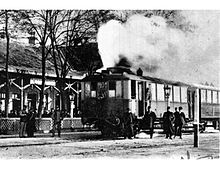MÁV series BCmot VIIIa, VIIIb
| MÁV series Cmot VIIIa, VIIIb | |||
|---|---|---|---|

|
|||
| numbering | MÁV: Cmot 07.301-304, 07.309-314 | MÁV: Cmot 07.305-308 | |
| Manufacturer | Ganz & Co. / Budapest | ||
| Years of construction | 1904 | ||
| Retirement | unknown | ||
| number | 10 | 4th | |
| Gauge | 1,435 mm | ||
| Top speed | 50 km / h | ||
| Length over buffers | 11,615 mm | 10,650 mm | |
| Service mass | 17.6 t | 18.1 t | |
| Friction mass | 11.5 t | ||
| control | Smart | ||
| design type | A1 'n2v | ||
| Number of cylinders | 4th | ||
| ND cylinder diameter | 170 mm | ||
| HD cylinder diameter | 116 mm | ||
| Piston stroke | 140 mm | ||
| Boiler design | De Dion-Bouton | ||
| Boiler pressure | 18 bar | ||
| Grate surface | 0.3 m² | ||
| Superheater surface | 2.7 m² | ||
| Evaporation heating surface | 5.7 m² | ||
| indicated performance | 37 kW (50 PS) | ||
| Wheel diameter | 1,020 mm | ||
| Seats | 40 | 38 | |
| Classes | 3. | ||
The two-axle steam railcar of MÁV series Cmot VIIIa were at 1904 Ganz & Co in Budapest produced and served as railcars for the Hungarian State Railways MÁV . Vehicles of this type were manufactured according to the De Dion-Bouton system and had an output of 37 kW (50 hp).
history
Railway lines of the Hungarian state railway MÁV were considered to be particularly steam railcar-friendly around the 1900s , as the company owned many branch lines with little traffic and relatively low gradients. Most of the vehicles required were manufactured by Ganz in Budapest. For this purpose, the company acquired licenses from De Dion-Bouton and built steam railcars with 35, 50 and 80 hp.
According to the literature, a total of 89 steam railcars are said to have been delivered to MÁV by GANZ by the end of 1906; Pospichal only mentions 30 vehicles. These 14 steam railcars mentioned here can be considered the larger of all steam railcars in this category.
Originally two of them were planned as Weitzer-De Dion-Bouton railcars with benzene-electric railcars. Since this concept did not work, they were built by Ganz using a De Dion-Bouton steam engine . Both variants ( VIIIa or VIIIb ) are almost identical in structure.
Reliable information on the use of the vehicles cannot be found in the literature. A photograph shows a railcar on a local railway in Zrenjanin .
technical description
In terms of appearance, the vehicles were similar to the BCmot VIIc . The entry-level area is designed significantly differently, otherwise both vehicle types were roughly the same size class. Within the two sub-variants, the entry area of the VIIIb was moved a little further forward.
The vehicle had a water-tube boiler developed by De Dion-Bouton and manufactured by GANZ and a steam engine from the same manufacturer. The structure of the steam generator and steam engine was identical to that of the predecessor models; the output of this model was still 50 hp. According to literature, there have been vehicles with an output of 80 hp, a data sheet for such a vehicle cannot be found. The boiler was fed by two piston pumps driven by steam . The water tank was placed under the undercarriage of the car. It was filled either through a filling funnel from the roof with the water crane or through a jet pump from the driver's cab.
See also
literature
- Rolf Ostendorf: Steam railcars, types and systems , Motorbuchverlag, Stuttgart, ISBN 3-87943-517-0
- Alfred Horn: Steam railcars and baggage locomotives in Hungary , Bohmann Verlag KG Vienna: 1972
Web links
Individual evidence
- ^ A b Alfred Horn: Steam railcars and baggage locomotives in Hungary , Bohmann Verlag KG Vienna: 1972, page 33
- ↑ List of Hungarian steam engines at www.pospichal.net
